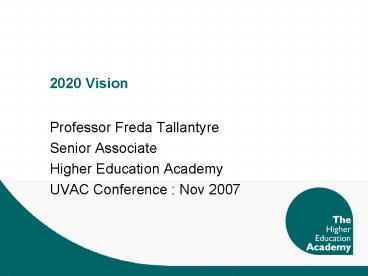2020 Vision - PowerPoint PPT Presentation
1 / 13
Title: 2020 Vision
1
2020 Vision
- Professor Freda Tallantyre
- Senior Associate
- Higher Education Academy
- UVAC Conference Nov 2007
2
Leitchs Stretching Targets
- World leader in skills by 2020 equiv to 8th out
of 30 OECD countries - Doubling attainment at most levels
- 95 achievement basic skills (v 85 literacy
79 numeracy - 90 qualified at level 2 (v 69 in 2005)
- Shift balance from Level 2 to Level 3, with 1.9
million additional attainments by 2020 - 40 adults qualified to Level 4 (v 29 in 2005)
5.5 million more attainments by 2020 (DfES say
need 45!)
3
Leitch Implementation Plan July 2007
Implications for HLS
- 1.9 million more people with level 3 qual by 2020
- Free Advanced Apprenticeship programmes for 19-25
- Statutory participation age up to 18?
- 12 National Skills Academies by 2008, 1 for
each major sector - 40 adults to have level 4 qual by 2020 (up
from 29), and 36 by 2014 - Public funding for T2G adult demand led learning
doubles by 2010/11, and employers contribute 50
of that in addition - HEFCE co-funds 5000 ASNs p.a. for next few years
- New universal adult careers service in England
- QCF will reflect only quals which meet standards
set by SSCs, and also accredited in-house
training programmes
4
HEFCE Implementation Plan Sept 2007
- HEFCE central team and national action group
- Joining up KT, research, innovation, FDs,
employability, WFD into coherent EE agenda - People in work with levels 2 or 3 and no 4 (ELQ)
brings 12 million potential new learners to HE - Equal status for business-facing with T and R
- Co-funded ASNs at 50 normal rate
- Focus on 6-8 key sectors, with SSCs, where HLS
critical - 100,000 FDs by 2010
- 10-15 HEIs deliver ¾ co-funding, with another
10-15 prepared - Modest changes to funding rules, pending new
methodology
5
Race to the Top Sainsbury Oct 2007
- 2020 50 exports from devel world (cf 10 1980)
- UK focus on high-value goods, services and
industry - Major campaign for STEM subjects
- Research HEIs focus on blue skies, teaching and
KT - Business-facing HEIs focus on professional
teaching, user-driven research and regional
consultancy - Fully formulaic HEIF, with emphasis upon SMEs
- KTPs doubled and shorter flexible KTP for SMEs
from HE and FE
6
Segregation of HE sector
- Economic accelerated by demographic trends
- a) Research, v.high entry UG, PGR, KT
- b) UG, PGT, international, parallel business
- c) Business-facing, flexible pedagogies and
services - d) ignore agenda and mistake position (a few
serious business failures by 2020 for HEFCE to
address) - e) FECs compete on sub-degrees, suffer via
demographic trends and need to focus on adult
agenda
7
A different cut partnerships
- CoE across regions, via HE-HE and HE-FE
partnerships and physical and virtual provision
(case) - Regional partnerships, consortia and alliances,
e.g. White Rose, Coalfields, Cornwall, LLNs,
HLSPs (case) - HEI-industry partnerships university
corporates community business services e.g.
Coalfields, Herts (case) - New workforce models joint appointments,
industry associates, parallel workforces (cases)
8
Case Study Foundation degree frameworks
- RAF, Chester, Derby, OU and Staffordshire, ILM
- WBL integral and flexible learning styles
- Staff can continue studies if posted overseas
- Framework covers different career paths
- Achieve ILM Diploma as well as academic award
- Helps staff transfer into civilian life
9
Case Study Partnership
- HLSPs aim to incorporate HE into workforce
development and the latter into HE strategy, and
develop co-funding - Intermediaries placed in HEIs identify and source
WFD - Support development of flexible pedagogies
- Seam provision from variety of providers for
employers - Test funding methodologies
- Identify barriers, good practice, skills
requirements - Driving culture change
10
Case Study Business facing universities
- Focus on professional teaching, user-driven
research and problem-solving with local and
regional companies Sainsbury report - Hertfordshire operates county business link with
50k businesses - Increase in applied research, pdp progs, student
placements amd employability skills - Innovation Centre supports student and staff
enterprise - Biopark supporting SMEs in bioscience and health
technology, including 2 spin-outs from
University. Staff and students engage in the
businesses.
11
Case Study Confetti
- Private learning institute for the Creative
Industries - Partnership with Castle College and DMU for
theory - Practical learning in state of the art commercial
recording and film and TV production studios - Work with schools and colleges and offer HND,
FDSc and BSc awards - Staff are practising professionals
- Micro model within a single film enterprise, and
macro model across a range of creative industries
12
Case Study Employer Engagement
- Surrey and Sussex SHA supported practice
development facilitator roles - Innovative ways of delivering CPD in practice
setting - Honorary contracts with University of Surrey
- Combine strategic, clinical, interpersonal and
educational functions - Critically evaluate practice to stimulate
development and sustainability of best practice - Develop learning initiatives to meet service
requirements - Integrate policy aims with specific ward culture
- Design learning capable of university
accreditation - High learner satisfaction and positive impact on
patient care
13
National adjustments
- New HE funding methodology c2010 credit,
flexibility, risk-based, incentivises diversity,
co-funding variant - QA revised Code of Practice moves to more
industry compatible model based on customer
satisfaction - Heightened planning measures, e.g. STEM, sectors,
regions, age groups (limited success and some
unforseen consequences) - Undercut by increased liberation of many HEIs
from FC influence because of predominance of
other income - SSDA ESC SSCs TECs (or
something) - Co-funding replaced by training levies/
incentives

